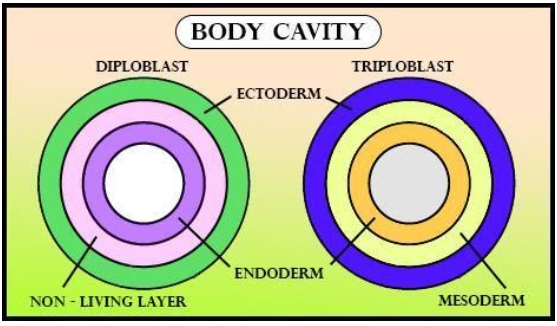
Answer
450.6k+ views
Hint: Among the group of organisms given, the genus that shows diploblastic organisation belongs to marine, colonial cnidarians. These organisms exhibit the property of bioluminescence. A typical example is sea pens.
Complete answer:
Pennatula has a diploblastic organisation. Let's begin the explanation by learning about the diploblastic organisation. As diplo means double and blastic means cell layer, animals in which the cells are arranged in two embryonic layers, an external ectoderm and an internal endoderm, are said to be ‘diploblastic.’ When a mesodermal layer is present between ectoderm and endoderm, the organism is said to be ‘triploblastic.’
Additional Information: There are certain characters that help in the classification of an organism. These are:
Level of body organisation: It means the organism is made of only cells, or cell combines to form tissues, have organ or organ system organization.
Body Symmetry: It is the distribution of body parts in an organism in reference to the body axis. If the organism does not divide into two equal halves, it is known as ‘asymmetrical’ like sponges. The other two are radial and bilateral. ‘Radial symmetry’ is in which the organism can be divided into two halves through any plane while when an organism can be divided into identical right and left halves only in one plane, it is said to be ‘bilateral.’
Germ layers: It is defined as layers that are responsible for the formation of tissues and organs. Based on this, organisms are of two types. The ones who have two layers are ‘diploblastic’ while higher organisms have three layers known as ‘triploblastic.’ All animal phyla except sponges and coelenterates are triploblastic
Body Cavity: Scientists also keep the presence of the body cavity in consideration while classifying organisms. This body cavity is known as coelom and is lined by the mesoderm layer. Annelids, molluscs, arthropods, echinoderms, hemichordates and chordates are coelomates. In some organisms like in aschelminthes, there exist pouches in between ectoderm and endoderm. Such organisms are called ‘pseudocoelomates.’
So, the correct answer is, ‘Pennatula.’
Note: -Paramoecium is one of the simplest and most abundant life forms of the group Protozoa. Specialized tissues are absent in paramoecium. Instead, it is a mass of protoplasm, perhaps representing a single cell.
-Polystomella is also a unicellular, dimorphic protozoan. It is about 1 mm in diameter.
-Along with the above organisms, entamoeba is also included in the Protozoa. It lives as internal parasites or commensals of animals.

Complete answer:
Pennatula has a diploblastic organisation. Let's begin the explanation by learning about the diploblastic organisation. As diplo means double and blastic means cell layer, animals in which the cells are arranged in two embryonic layers, an external ectoderm and an internal endoderm, are said to be ‘diploblastic.’ When a mesodermal layer is present between ectoderm and endoderm, the organism is said to be ‘triploblastic.’
Additional Information: There are certain characters that help in the classification of an organism. These are:
Level of body organisation: It means the organism is made of only cells, or cell combines to form tissues, have organ or organ system organization.
Body Symmetry: It is the distribution of body parts in an organism in reference to the body axis. If the organism does not divide into two equal halves, it is known as ‘asymmetrical’ like sponges. The other two are radial and bilateral. ‘Radial symmetry’ is in which the organism can be divided into two halves through any plane while when an organism can be divided into identical right and left halves only in one plane, it is said to be ‘bilateral.’
Germ layers: It is defined as layers that are responsible for the formation of tissues and organs. Based on this, organisms are of two types. The ones who have two layers are ‘diploblastic’ while higher organisms have three layers known as ‘triploblastic.’ All animal phyla except sponges and coelenterates are triploblastic
Body Cavity: Scientists also keep the presence of the body cavity in consideration while classifying organisms. This body cavity is known as coelom and is lined by the mesoderm layer. Annelids, molluscs, arthropods, echinoderms, hemichordates and chordates are coelomates. In some organisms like in aschelminthes, there exist pouches in between ectoderm and endoderm. Such organisms are called ‘pseudocoelomates.’
So, the correct answer is, ‘Pennatula.’
Note: -Paramoecium is one of the simplest and most abundant life forms of the group Protozoa. Specialized tissues are absent in paramoecium. Instead, it is a mass of protoplasm, perhaps representing a single cell.
-Polystomella is also a unicellular, dimorphic protozoan. It is about 1 mm in diameter.
-Along with the above organisms, entamoeba is also included in the Protozoa. It lives as internal parasites or commensals of animals.

Recently Updated Pages
Identify the feminine gender noun from the given sentence class 10 english CBSE

Your club organized a blood donation camp in your city class 10 english CBSE

Choose the correct meaning of the idiomphrase from class 10 english CBSE

Identify the neuter gender noun from the given sentence class 10 english CBSE

Choose the word which best expresses the meaning of class 10 english CBSE

Choose the word which is closest to the opposite in class 10 english CBSE

Trending doubts
Capital of the Cheras was A Madurai B Muziri C Uraiyur class 10 social science CBSE

How do you graph the function fx 4x class 9 maths CBSE

A Tesla is equivalent to a A Newton per coulomb B Newton class 9 physics CBSE

Which are the Top 10 Largest Countries of the World?

The capital of British India was transferred from Calcutta class 10 social science CBSE

Fill the blanks with the suitable prepositions 1 The class 9 english CBSE

What is spore formation class 11 biology CBSE

Queen Victoria became the Empress of India according class 7 social science CBSE

Who was the first scientist to propose a model for class 11 chemistry CBSE




